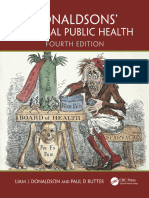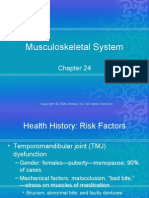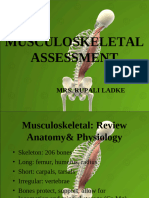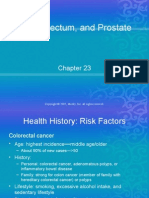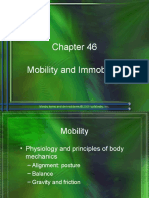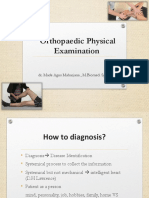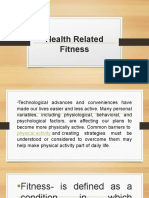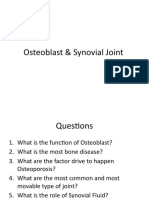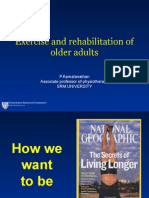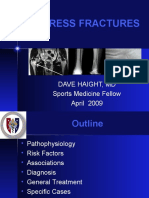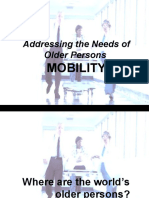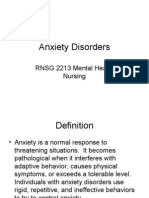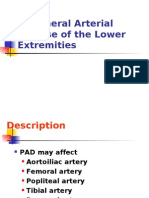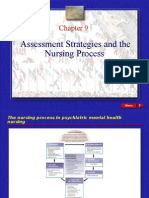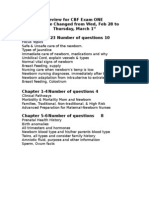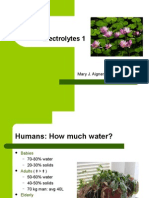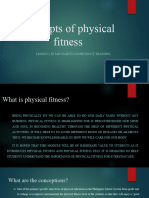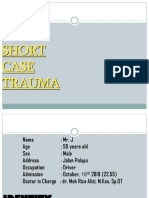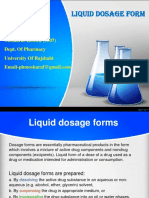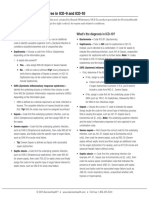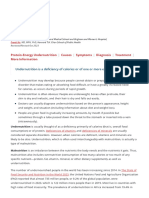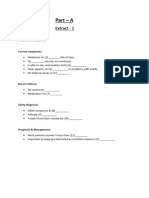0 ratings0% found this document useful (0 votes)
58 viewsChapter 024
Chapter 024
Uploaded by
api-3697326Gout - increase in serum uric acid levels, tophi - - Gender: men higher risk Age: (30 to 50 years) family history: positive family history thyroid dysfunction: higher prevalence with hypothyroidism - Obesity: link between high uric acids levels and body weight - Alcohol: alcohol use (bingeing) highly associated with gout. Osteoporosis - Age: bone density decreases beginning at age 35.
Copyright:
Attribution Non-Commercial (BY-NC)
Available Formats
Download as PPT, PDF, TXT or read online from Scribd
Chapter 024
Chapter 024
Uploaded by
api-36973260 ratings0% found this document useful (0 votes)
58 views23 pagesGout - increase in serum uric acid levels, tophi - - Gender: men higher risk Age: (30 to 50 years) family history: positive family history thyroid dysfunction: higher prevalence with hypothyroidism - Obesity: link between high uric acids levels and body weight - Alcohol: alcohol use (bingeing) highly associated with gout. Osteoporosis - Age: bone density decreases beginning at age 35.
Copyright
© Attribution Non-Commercial (BY-NC)
Available Formats
PPT, PDF, TXT or read online from Scribd
Share this document
Did you find this document useful?
Is this content inappropriate?
Gout - increase in serum uric acid levels, tophi - - Gender: men higher risk Age: (30 to 50 years) family history: positive family history thyroid dysfunction: higher prevalence with hypothyroidism - Obesity: link between high uric acids levels and body weight - Alcohol: alcohol use (bingeing) highly associated with gout. Osteoporosis - Age: bone density decreases beginning at age 35.
Copyright:
Attribution Non-Commercial (BY-NC)
Available Formats
Download as PPT, PDF, TXT or read online from Scribd
Download as ppt, pdf, or txt
0 ratings0% found this document useful (0 votes)
58 views23 pagesChapter 024
Chapter 024
Uploaded by
api-3697326Gout - increase in serum uric acid levels, tophi - - Gender: men higher risk Age: (30 to 50 years) family history: positive family history thyroid dysfunction: higher prevalence with hypothyroidism - Obesity: link between high uric acids levels and body weight - Alcohol: alcohol use (bingeing) highly associated with gout. Osteoporosis - Age: bone density decreases beginning at age 35.
Copyright:
Attribution Non-Commercial (BY-NC)
Available Formats
Download as PPT, PDF, TXT or read online from Scribd
Download as ppt, pdf, or txt
You are on page 1of 23
Musculoskeletal System
Chapter 24
Copyright © 2005, Mosby, Inc. All rights reserved.
Health History: Risk Factors related to
Musculoskeletal system
• Gout- increase in serum uric acid levels, tophi
– Gender: men higher risk
– Age: (30 to 50 years)
– Family history: positive family history
– Thyroid dysfunction: higher prevalence with
hypothyroidism
– Obesity: link between high uric acid levels and body weight
– Hypertension: clients with gout also hypertension
• Use of diuretics highly associated with gout
– Alcohol: alcohol use (bingeing) highly associated with gout
– Earliest signs acute onset pain in Great Toe- classic
Copyright © 2005, Mosby, Inc. All rights reserved.
Gout tophi
Copyright © 2005, Mosby, Inc. All rights reserved.
Health History: Risk Factors
• Osteoporosis
– Age: bone density decreases beginning at age 35
– Gender: women less bone tissue, lose it more readily
than men
– Race: Whites/Asians have increased risk
– Bone structures/body weight: small-boned, thin
women (<127 lb) at greater risk
– Family history: positive history increases risk
– Lifestyle: smoking, alcohol intake, inadequate
calcium, inadequate weight-bearing increase risk
– Medications-glucocorticoids, methotrexate, thyroid
hormone, heparin
Copyright © 2005, Mosby, Inc. All rights reserved.
Health History: Risk Factors
• Hip fracture
– Age: most occur after age 75
– Genetics: maternal hip fracture increases risk
– Body size: tall at young age, thin, losing >10% of
body weight since age 25
– Osteoporosis: porous bone decreases bone strength
– Fluoride: fluoride deficit weakens bone
– Medications: sedatives, long-acting benzodiazepines
increase risk
– Caffeine: consumption of any form increases risk
Copyright © 2005, Mosby, Inc. All rights reserved.
Problem-Based History: Pain
• Where was pain felt? First noticed?
Related to movement? Describe how it
feels. Severity (0 to 10)?
• Did pain occur suddenly? During day
when do you feel pain?
• Does pain move one joint to another? Any
injury, overuse, or strain of muscles/joints?
Ill before onset?
Copyright © 2005, Mosby, Inc. All rights reserved.
Problem-Based History: Pain
• What makes pain worse? Change with
weather? Does pain shoot to another part
of your body?
• What was done to relieve the pain? How
effective was that?
• Pain that reduces with movement and as
the day goes on, associated with the joints
could be rheumatoid arthritis.
Copyright © 2005, Mosby, Inc. All rights reserved.
Examination: Overview
• To examine the musculoskeletal system,
use a cephalocaudal organization with
side-to-side comparisons for examining
bones, muscles, and joints
• Because there are often no “normals” for
the musculoskeletal system, to establish
normality, it is best to compare with other
side
Copyright © 2005, Mosby, Inc. All rights reserved.
Normal position for inspection
Copyright © 2005, Mosby, Inc. All rights reserved.
Examination
• Techniques used depend on reason for exam,
setting, condition and age of the client, skill of
the nurse
• Findings during exam may warrant use of
additional techniques
• Nurse determines which techniques should be
indicated for each exam
Copyright © 2005, Mosby, Inc. All rights reserved.
Examination:
Procedures and Techniques
• Inspect axial skeleton/extremities—alignment,
contour, symmetry, size, and gross deformities
– Body symmetric, straight spine (normal curves), knees
straight line (hips – ankles), feet flat, forward
– Have them bend over and touch their knees, this will
help you evaluate the straightness of the spine.
• Inspect muscles—size and symmetry
– Bilateral symmetry,
Copyright © 2005, Mosby, Inc. All rights reserved.
Inspection for Spine- Scolosis
Copyright © 2005, Mosby, Inc. All rights reserved.
Examination:
Procedures and Techniques
• Test muscle strength and compare
contralateral sides
– Part of MS/neuro exam
– Flex muscle, then resist when force applied
– Bilaterally symmetric with full resistance to
opposition
Copyright © 2005, Mosby, Inc. All rights reserved.
Testing for Upper arm strength
Copyright © 2005, Mosby, Inc. All rights reserved.
Examination:
Procedures and Techniques
Specific regions
• Observe gait—conformity, symmetry, and
rhythm
– Conformity, regular smooth rhythm, leg swing length
symmetry, smooth swaying/symmetric arm swing
• Inspect face/neck musculature—symmetry
• Palpate temporomandibular joint—movement,
sounds, tenderness
– Smooth jaw movement, without pain
(audible/palpable snap ok)
Copyright © 2005, Mosby, Inc. All rights reserved.
Examination:
Procedures and Techniques
Specific regions
• Inspect hips for symmetry
– Hips equal height/symmetric
• Test hips—muscle strength
– Raise leg from supine position—able to overcome resistance-
this will test normal range of hyperextension of the hip.
– Extend leg from sitting position—able to maintain extension
– Bend knee—able to maintain flexion
Copyright © 2005, Mosby, Inc. All rights reserved.
Age-Related Variations:
Older Adults
Anatomy and physiology
• Aging accompanied by number of
musculoskeletal changes
– Decrease in bone mass—increasingly
vulnerable to stress in weight-bearing areas
and resultant fractures
– Intervertebral disks lose water—narrowing of
disk space; loss of 1.5 to 3 inches in height
– Lordotic or convex curve of back flattens;
flexion/extension of back decrease
Copyright © 2005, Mosby, Inc. All rights reserved.
Age-Related Variations:
Older Adults
Health history
• What daily activities: bathing, dressing, eating,
exercising? Need assistance? Who provides
care?
• Any gadgets to help? Describe.
• What have they done to prevent falls in their
residence? Adequate lighting, particularly over
steps? Grab bars where needed (steps/beside
bathtub)? Throw rugs in residence? Intrinsic vs
Extrinsic risk factors
Copyright © 2005, Mosby, Inc. All rights reserved.
Age-Related Variations:
Older Adults
Examination: procedures and techniques
• Examination—same as that of younger adult
• May be slower at performing range-of-motion
exercises, and muscle-strength assessments
may be below 5/5
• Observe gait of older client
– Observation of mobility is single most important
determinant of client’s risk of falling
Copyright © 2005, Mosby, Inc. All rights reserved.
Age-Related Variations:
Older Adults
Normal and abnormal findings
• Normal findings same as for younger adult
• Abnormal findings include:
– Osteoarthritic changes in joints; muscle
atrophy from disuse
– Many joints may not have expected degree of
movement or range of motion
– Deep tendon reflexes such as Achilles tendon
reflexes may be diminished
Copyright © 2005, Mosby, Inc. All rights reserved.
Common Disorders of the Joints-
Rheumatoid Arthritis
Copyright © 2005, Mosby, Inc. All rights reserved.
Common Problems and Conditions:
Bones
Fracture
• Partial/complete break in continuity of a bone
– Skin intact in closed fracture, and skin broken in open
fracture
– Pathologic fracture—results from weakness in bone,
(osteoporosis or neoplasm)
– Clinical findings
• Pain caused by muscle spasm is common
• Deformity/loss of function—tissue shortening
around bone and localized edema
Copyright © 2005, Mosby, Inc. All rights reserved.
Fractures
Copyright © 2005, Mosby, Inc. All rights reserved.
You might also like
- Donaldsons' Essential Public Health (PDFDrive)Document375 pagesDonaldsons' Essential Public Health (PDFDrive)anibiris12No ratings yet
- Mobility and Immobility: Group 1Document46 pagesMobility and Immobility: Group 1Andrea Huecas Tria86% (7)
- Pharm Phlash - Pharmacology Phlash Cards 2 EditionDocument469 pagesPharm Phlash - Pharmacology Phlash Cards 2 EditionDr Notes100% (4)
- Osteoporosis PowerpointDocument45 pagesOsteoporosis PowerpointAgustina Anggraeni Purnomo100% (1)
- Quail Eggs Therapy Booklet - EbookDocument9 pagesQuail Eggs Therapy Booklet - Ebookbicagency100% (4)
- BM Forms Instructional Revised2005Document15 pagesBM Forms Instructional Revised2005Mem Anderson BuyagaoNo ratings yet
- Chapter 024Document35 pagesChapter 024api-3697326No ratings yet
- Chapter 025Document34 pagesChapter 025api-3697326No ratings yet
- Chapter 013Document12 pagesChapter 013api-3697326No ratings yet
- Chapter 023Document26 pagesChapter 023api-3697326No ratings yet
- Chapter 020Document33 pagesChapter 020api-3697326No ratings yet
- Musculoskeletal AssessmentDocument9 pagesMusculoskeletal AssessmentVincent John FallerNo ratings yet
- V.Lokeesan, BSN T.Assistant Lecturer FHCS, EuslDocument39 pagesV.Lokeesan, BSN T.Assistant Lecturer FHCS, EuslMourian AmanNo ratings yet
- Musculoskeletal Assessment: Nur123 Spring 2009 K. Burger, Msed, MSN, RN, CneDocument31 pagesMusculoskeletal Assessment: Nur123 Spring 2009 K. Burger, Msed, MSN, RN, Cneipunklhah77No ratings yet
- Senior AdjustingDocument30 pagesSenior AdjustingBranden BlausteinNo ratings yet
- Common Pathologies of The HipDocument81 pagesCommon Pathologies of The HipRehab NaeemNo ratings yet
- Chapter 010Document51 pagesChapter 010api-3697326No ratings yet
- 2. Assessment of Muscoloskeletal systemDocument32 pages2. Assessment of Muscoloskeletal systemRupaliNo ratings yet
- Activity and ExerciseDocument30 pagesActivity and ExerciseSIVA KRISHNA PRASAD ARJANo ratings yet
- Osteoporosis BrochureDocument2 pagesOsteoporosis BrochurednllkzaNo ratings yet
- KIN - 308 - Developmental Anatomy - Fall2023Document77 pagesKIN - 308 - Developmental Anatomy - Fall2023brendanlmurphy123No ratings yet
- Chapter 023Document12 pagesChapter 023api-3697326No ratings yet
- Chapter 021Document6 pagesChapter 021api-3697326No ratings yet
- Locomotory ExaminationDocument32 pagesLocomotory ExaminationAditya AnandNo ratings yet
- Guidelines - Pengkajian Sistem MusculoskeletalDocument7 pagesGuidelines - Pengkajian Sistem MusculoskeletalJoy Harrys PriikitiewwNo ratings yet
- Arthritis 1Document25 pagesArthritis 1NOORUDDINNo ratings yet
- OsteoporosisDocument43 pagesOsteoporosisahmedmufleh250No ratings yet
- Upper and Lower Limb History ChecklistDocument5 pagesUpper and Lower Limb History ChecklistseanselvamaniNo ratings yet
- Lecturas Unidas Ing MedDocument49 pagesLecturas Unidas Ing MedLizbeth P. P.No ratings yet
- Assessment of Musculoskeletal SystemDocument12 pagesAssessment of Musculoskeletal SystemDina Thomas100% (6)
- Musculoskeletal DisabilityDocument18 pagesMusculoskeletal DisabilityMaria CamilleNo ratings yet
- Activity and ExerciseDocument31 pagesActivity and ExerciseojastcastrocesarNo ratings yet
- Guidetocare: For PatientsDocument2 pagesGuidetocare: For PatientsS Indah NoviantiNo ratings yet
- Mobility and Immobility: Mosby Items and Derived Items © 2005 by Mosby, IncDocument23 pagesMobility and Immobility: Mosby Items and Derived Items © 2005 by Mosby, IncmolyebeedNo ratings yet
- Low Back Pain Blue CrossDocument39 pagesLow Back Pain Blue CrossayazirezaNo ratings yet
- Skeletalhste 2Document33 pagesSkeletalhste 2api-209542414No ratings yet
- Arthistis, OA, OsteoporosisDocument32 pagesArthistis, OA, OsteoporosisKunal PaulNo ratings yet
- 10 Hip Replacement SurgeryDocument13 pages10 Hip Replacement SurgeryDIA PHONG THANGNo ratings yet
- Limb Lengthening SurgeryDocument12 pagesLimb Lengthening Surgerypav20021No ratings yet
- Orthopaedics Clinical ExamDocument6 pagesOrthopaedics Clinical ExamSugar MusicNo ratings yet
- Pemeriksaan Fisik Orthopedi eDocument61 pagesPemeriksaan Fisik Orthopedi eSurya AbigamikaNo ratings yet
- 404 SK Pre Participation EvaluationDocument37 pages404 SK Pre Participation Evaluationleo samNo ratings yet
- Effects of Aging On The Musculoskeletal SystemDocument11 pagesEffects of Aging On The Musculoskeletal SystemAlexa Mae TumibayNo ratings yet
- Health Related Fitness PPT WEEK 3 4Document17 pagesHealth Related Fitness PPT WEEK 3 4Ash LeyNo ratings yet
- Total Hip ReplacementDocument16 pagesTotal Hip Replacementabanoub sameerNo ratings yet
- MR Bones For CSDDocument6 pagesMR Bones For CSDaims_sluNo ratings yet
- Osteoprosis هامyDocument57 pagesOsteoprosis هامyNada GaberNo ratings yet
- Osteoblast & Synovial JointDocument18 pagesOsteoblast & Synovial JointDeviNo ratings yet
- Lesson 1 Conditioning For Physical FitnessDocument49 pagesLesson 1 Conditioning For Physical Fitnessglenlcy100% (1)
- Diagnosis in Orthopaedic: David Hariadi Masjhoer SMF Orthopedi & Traumatologi RSUD A W SjahranieDocument24 pagesDiagnosis in Orthopaedic: David Hariadi Masjhoer SMF Orthopedi & Traumatologi RSUD A W SjahranieOkki Masitah Syahfitri NasutionNo ratings yet
- Exercise and Rehab OldDocument71 pagesExercise and Rehab OldAyyappan JayavelNo ratings yet
- 20 - Physiotherapy in GeriatricsDocument29 pages20 - Physiotherapy in Geriatricsayesharajput5110No ratings yet
- Osteoporosisfor PDocument27 pagesOsteoporosisfor PAman TyagiNo ratings yet
- Chapter 016Document23 pagesChapter 016api-3697326No ratings yet
- Children and Women in SportsDocument11 pagesChildren and Women in Sportsayushbhusara8r8No ratings yet
- Unit 11 OsteoporosisDocument105 pagesUnit 11 OsteoporosisAaliya ZehraNo ratings yet
- Pechs - Support and Movement Class 10Document64 pagesPechs - Support and Movement Class 10ammara hyderNo ratings yet
- Stress Fractures: Dave Haight, MD Sports Medicine Fellow April 2009Document45 pagesStress Fractures: Dave Haight, MD Sports Medicine Fellow April 2009Gunjan PatilNo ratings yet
- Running InjuriesDocument32 pagesRunning Injuriesmariajaved0089No ratings yet
- Addressing The Needs of Older Persons: MobilityDocument104 pagesAddressing The Needs of Older Persons: MobilityBernie Cabalang ButacNo ratings yet
- Running Injuries Handbook: Identification, Treatment and Prevention to Keep You RunningFrom EverandRunning Injuries Handbook: Identification, Treatment and Prevention to Keep You RunningNo ratings yet
- Stretching for 50+: A Customized Program for Increasing Flexibility, Avoiding Injury and Enjoying an Active LifestyleFrom EverandStretching for 50+: A Customized Program for Increasing Flexibility, Avoiding Injury and Enjoying an Active LifestyleRating: 4 out of 5 stars4/5 (5)
- 9cc97fec Bbed 44bf b69c 5e52a52a9faeDocument49 pages9cc97fec Bbed 44bf b69c 5e52a52a9faeapi-3697326No ratings yet
- Cha 0014Document9 pagesCha 0014api-3697326No ratings yet
- Peripheral Arterial Disease of The Lower ExtremitiesDocument25 pagesPeripheral Arterial Disease of The Lower Extremitiesapi-3697326100% (1)
- Instructors's DP Spring 07Document1 pageInstructors's DP Spring 07api-3697326No ratings yet
- Daily PlanDocument2 pagesDaily Planapi-3697326100% (1)
- CH 09Document20 pagesCH 09api-3697326100% (1)
- Cha 0009Document8 pagesCha 0009api-3697326No ratings yet
- Review For CBF Exam ONEDocument2 pagesReview For CBF Exam ONEapi-3697326No ratings yet
- Cha 0011Document7 pagesCha 0011api-3697326No ratings yet
- Cha 0012Document6 pagesCha 0012api-3697326100% (1)
- Cha 0001Document7 pagesCha 0001api-3697326No ratings yet
- Respirations 1Document42 pagesRespirations 1api-3697326No ratings yet
- Respiratory 4 Spring 07Document26 pagesRespiratory 4 Spring 07api-3697326No ratings yet
- Learning Guide: Central Texas College Department of NursingDocument26 pagesLearning Guide: Central Texas College Department of Nursingapi-3697326No ratings yet
- Respiratory 3Document36 pagesRespiratory 3api-3697326No ratings yet
- P A I N 1my Power PointDocument38 pagesP A I N 1my Power Pointapi-3697326100% (1)
- Chapter 023Document12 pagesChapter 023api-3697326No ratings yet
- Fe 2Document26 pagesFe 2api-3697326No ratings yet
- Fe 1Document36 pagesFe 1api-3697326No ratings yet
- Fe 4Document36 pagesFe 4api-3697326No ratings yet
- Fe 3Document43 pagesFe 3api-3697326No ratings yet
- FE2 OutlineDocument9 pagesFE2 Outlineapi-3697326No ratings yet
- FE3 ABbalanceoutlineDocument9 pagesFE3 ABbalanceoutlineapi-3697326No ratings yet
- Chapter 027Document66 pagesChapter 027api-3697326No ratings yet
- Chapter 021Document6 pagesChapter 021api-3697326No ratings yet
- Class Schedule TableDocument1 pageClass Schedule Tableapi-3697326No ratings yet
- Jurnal ComfortDocument12 pagesJurnal ComfortrizkaNo ratings yet
- Medical Terminology CH 9Document104 pagesMedical Terminology CH 9ياسين المسطو100% (1)
- Gastric and Doudenal Peptic Ulcer: DR - Rania Khalil MostafaDocument44 pagesGastric and Doudenal Peptic Ulcer: DR - Rania Khalil MostafaMai OssamaNo ratings yet
- Journal of Hand Therapy: Hayat Hamzeh PT, MSC, Mohammad Madi PT, PHD, Alia A. Alghwiri PT, PHD, Ziad Hawamdeh MD, PHDDocument9 pagesJournal of Hand Therapy: Hayat Hamzeh PT, MSC, Mohammad Madi PT, PHD, Alia A. Alghwiri PT, PHD, Ziad Hawamdeh MD, PHDWinda FRNo ratings yet
- Oral Communication C Declamation and TalkDocument5 pagesOral Communication C Declamation and TalkPaula SalvosaNo ratings yet
- FatigueDocument8 pagesFatigueSabeeh Ul HassanNo ratings yet
- Concept of Physical FitnessDocument14 pagesConcept of Physical Fitnessrafaelarmildez02No ratings yet
- 15-10-2019, Mr. Jamal, 50 Yo, V.Laceratum Cruris Dextra + Skin Loss + Fraktur Os Fibula, Dr. Moh. Rizal Alizi, M.Kes, Sp. OT-1Document15 pages15-10-2019, Mr. Jamal, 50 Yo, V.Laceratum Cruris Dextra + Skin Loss + Fraktur Os Fibula, Dr. Moh. Rizal Alizi, M.Kes, Sp. OT-1anon_893244902No ratings yet
- LDF 20new 130717015450 Phpapp01Document20 pagesLDF 20new 130717015450 Phpapp01tariqwaeceNo ratings yet
- 10 Diseases and Immunity IGCSE CIE Biology Ext Theory MS - UpdatedDocument5 pages10 Diseases and Immunity IGCSE CIE Biology Ext Theory MS - UpdatedAsma Ali KhanNo ratings yet
- PVT 0715 ToolDocument1 pagePVT 0715 Toolsyaiful rinantoNo ratings yet
- Enema Bowel Elimination HandoutDocument15 pagesEnema Bowel Elimination Handoutayujabami34No ratings yet
- Unit 3 1Document19 pagesUnit 3 1Preeti ChouhanNo ratings yet
- 6 PartographDocument50 pages6 PartographEdelyn Arguelles100% (1)
- Commonly Prescribed Psychotropic MedicationsDocument2 pagesCommonly Prescribed Psychotropic MedicationsDragutin Petrić100% (1)
- BGR 34 For Diabetes - Ayur Times PDFDocument32 pagesBGR 34 For Diabetes - Ayur Times PDFSomanshu BanerjeeNo ratings yet
- Office Of: The SecretaryDocument44 pagesOffice Of: The Secretarypaomillan0423No ratings yet
- 2014 LeprosyDocument5 pages2014 LeprosySejal ThakkarNo ratings yet
- Undernutrition - Disorders of Nutrition - MSD Manual Consumer VersionDocument12 pagesUndernutrition - Disorders of Nutrition - MSD Manual Consumer Versionyetunde alozieNo ratings yet
- Lumbar PunctureDocument27 pagesLumbar PunctureWitneyGrace100% (1)
- Sehaj Chahal Updated CVDocument3 pagesSehaj Chahal Updated CVsehajchahalNo ratings yet
- Listening 68-1Document8 pagesListening 68-1nurdalynarakama1994No ratings yet
- MaturitasDocument3 pagesMaturitasCarolinaNo ratings yet
- Level 7 - April 14thDocument4 pagesLevel 7 - April 14thAlex AmarfilNo ratings yet
- Chapter 1 of 10 - IntroductionDocument4 pagesChapter 1 of 10 - IntroductionspiritualbeingNo ratings yet
- Reports 2Document10 pagesReports 2Tejaswini ReddyNo ratings yet
